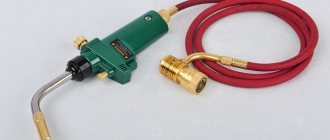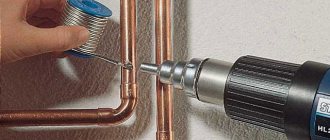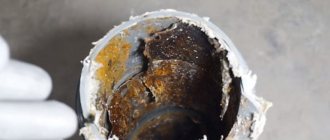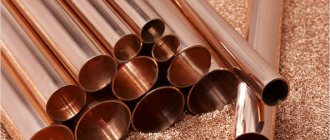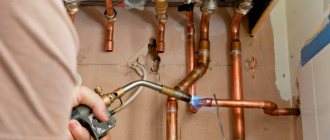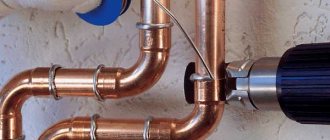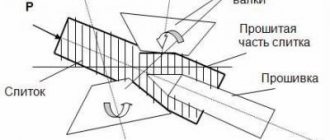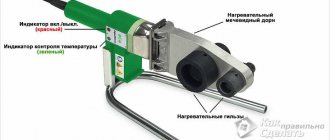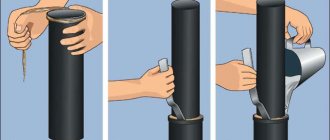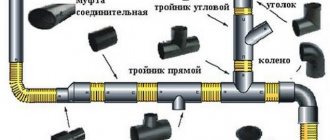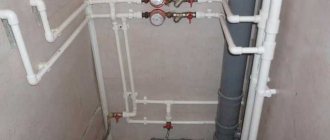The essence of the process
Pipes in heat generating and heat exchange units usually have a small diameter. Therefore, when butt welding such pipes, the burr formed inside significantly reduces the throughput of the unit, disrupting the performance of the pipeline.
The use of shaped elements inserted into the pipes being connected leads to the same result - the internal cross-section is reduced.
If, before connecting, the end of the pipe is widened and then put on another pipe, fitting or pipe of the connected device, loss of throughput can be avoided.
Note! Flaring, beading or beading is the expansion of one or both ends of the pipe and changing the shape of the edge. This forming makes it possible to make a socket of the desired shape at the end of a straight copper tube, which is necessary for connecting it with other structural elements.
The essence of the process is that a thin layer of metal softens under mechanical load and gradually takes on the desired shape. This increases the surface area and reduces the wall thickness of the pipe edge.
You can roll a pipe from any material, but in most cases it is technically difficult and does not justify the labor costs, since you can always buy either ready-made socket products or the necessary connecting elements.
At home, it is mainly copper tubes that are flared, which are relatively easy to deform due to the softness and elasticity of copper.
Communities › Kulibin Club › Blog › Zig machine. Machine for flaring (creating a side) of pipes
When installing intercoolers, you often have to cut aluminum pipes and connect them with silicone. At the same time, to prevent the silicone from jumping off, the pipe must be flared.
You can flare a pipe in various ways; in the Drive search you will find many options. But the most convenient, correct, high-quality and fastest option is to use a pipe flaring machine
Such machines are available for sale, but their price tag is very inhumane. 8000 rub.
I use this exact machine when I work with pipes in one of the workshops. Convenient and useful thing.
I am constantly adding to my personal arsenal of tools and have had my eye on such a machine for a long time. But the toad said that he would not give money and I had to make the machine myself.
And this is what I got.
The machine is completely made of stainless steel. It turned out to be heavier and larger than the machine that can be found on sale, but it’s worth it)
And now in more detail.
The advantage of my machine is that it can be mounted on the edge of a table or in a vice. The machine from the store can only be mounted in a vice. I made the clamp with which the machine is attached to the table removable, so that if necessary it would be easier to secure it in a vice.
From rotation on the axis, the rollers are fixed with cotter pins and tightened with bolts
Well, now the fun part! Machine test!
We take an aluminum pipe and clamp it between the rollers
By turning the rollers and gradually tightening the pressure screw, we form a bead on the pipe.
The result is a neat, even side
But that is not all!
Sometimes you come across cars where stainless steel pipes are used when installing the intercooler. Often they are not flared. We have to fix this.
I tried to flare stainless steel pipes on a machine for 8000. It’s clearly not for these purposes. Too flimsy.
Not like my machine!
Without much effort, my machine makes an excellent rim on stainless steel pipes!
If you sit down and think through the design of the machine more carefully, then of course you can make a more compact version. During the creation process, thoughts already appeared about what could be done more successfully, but for this we need to do everything from the beginning. There is neither time nor desire for this.
Another not unimportant point. On a machine from a store you can flare a pipe with a diameter of at least about 20 mm; on my machine it is not possible to flare such a pipe. The minimum internal pipe size for my machine is 28 mm. But for my purposes this is enough.
Thank you for your attention!
Flaring technology and stages
Copper tubes are connected to each other or to other elements of the pipe structure by welding or coupling.
Depending on the connection method (fitting or welded), the technology for preliminary preparation of the pipe edge differs.
- To complete the welded assembly, the end of the pipe is expanded - the hole is expanded until its internal diameter becomes 0.1-0.2 mm larger than the external diameter of the attached part. The gap between the elements to be connected will be filled with solder during the soldering process, which will ensure the strength and tightness of the assembly.
- To make a fitting connection between parts, the hole in the copper tube is not simply expanded to the required size, but a chamfer of the desired shape is prepared at the end, usually at an angle of 45⁰. This increases the contact area, thereby ensuring the reliability of the unit. The natural plasticity of copper also helps with this - when the joint is compressed with a fitting, the softened metal tightly grips the part attached to the pipe and fills all the gaps.
Regardless of the flaring task, the process steps are the same:
- The pipe is cut strictly perpendicularly, the edges and the outer surface near the cut are cleaned, and if the pipe was deformed during cutting, for example, flattened, the round shape of its cross-section is restored. Even partial failure to complete this step can lead to the fact that the connection will not be reliable and will easily depressurize.
- Fix the pipe in the matrix of the flaring tool or vice so as to leave approximately 5-6 mm of the pipe free. If the assembly will be made using the fitting method, first put a crimp nut on the pipe and only then fix the pipe in the holder. Putting a crimp nut on a flared pipe is problematic.
- A stamp of the required size is inserted into the end of the pipe and gradually screwed inward. In this case, the metal softens, stretches, and the edge of the pipe takes on a conical shape.
- Remove the expander from the pipe, release it from the holder and carefully inspect the resulting socket. If burrs are found along the edge, they are cleaned off.
It is important! If the bell has cracks, its edges are not parallel to each other or are skewed relative to the axis of the pipe, it is necessary to cut off the entire flared edge and repeat the beading process from the beginning.
Main varieties
The simplest design of the edge bending devices on the market are manual roller type devices. All manipulations with such edge benders are carried out using the handle with which they are equipped, and the main work of deforming the edge of the metal workpiece is performed by the rollers. The width of the bend performed using such a device is regulated by means of a special limiter installed on the guides of the device.
Compact manual edge benders can be used directly on site
High mobility of the edge bender, which can be used even on high-rise objects, is ensured not only by its compact dimensions, but also by its low weight, about 2 kg. Using a hand-held edge bending tool, you can bend the edge of a metal workpiece at an angle of up to 90°, while the thickness of the metal from which it is made cannot exceed 0.8 mm.
Using an edge bender, you can make bends of any length, and their width can be in the range of 0.5–20 cm. As can be seen from the technical characteristics of such a device, its capabilities are quite limited, so it is advisable to use it only for solving simple technological problems. An edge bending machine equipped with a hydraulic drive is more productive and functional. The operator working on such equipment does not need to exert significant physical effort in order to bend the edge of a metal workpiece. Due to the high power that this device is distinguished by, it can be used for processing sheet metal workpieces even of considerable thickness.
Edge bending machine ZSH-4.0 with hydraulic roller clamping
Depending on the dimensions, a hydraulic edge bending machine can be stationary or mobile. It is the hydraulic drive that is most often equipped with such equipment, which also has another name - “edge bending press”.
The edge bending machine can also be equipped with an electromechanical drive. Using this equipment, you can make folds of various types and even perform upsetting of the folded seam, if the equipment of the machine allows this to be done.
Making an edge or trimming it on a roller machine uses replaceable rollers, on which the shape of the bend depends
Edge benders equipped with a pneumatic drive are very popular. The working parts of such a machine, operating on the “rotary beam” principle, through the use of a pneumatic drive, make it possible to exert significant pressure on the workpiece being processed, the value of which can reach up to 6.2 bar. Meanwhile, such an edge bending machine can be used for processing workpieces made of sheet metal, the thickness of which does not exceed 1.2 mm, while the width of the processed edge cannot be more than 12 mm. When deciding to use serial equipment in this category or make a pneumatic machine with your own hands, you must keep in mind that for such a device to fully operate, it is necessary to provide an air flow of 113 l/min.
Tools
You can increase the diameter of a soft and elastic copper pipe manually by simply pulling it onto a conical blank of a suitable size.
However, it is very difficult to obtain a bell with the correct geometry using this artisanal method. The walls may have uneven thickness, causing thinner ones to stretch too much and thick ones not to stretch at all. The force applied by a person is also uneven, so it is possible that the pipe will bend during operation and the blank will be skewed, as a result of which the socket will turn out to be asymmetrical and skewed.
To make the beading carefully and form a socket of the desired shape from the edge of the pipe, which can subsequently ensure a reliable connection of structural elements, various tools are used.
This is a manual mechanism in which flaring is carried out simply by applying force, just like when using a conical blank. The expander consists of two handles and an expander - a sliding conical element that is inserted into the pipe. When the levers are acted upon, parts of the expander diverge in different directions, stretching the pipe.
The expander is inexpensive and allows you to get the job done quickly and without much labor. However, it is difficult to obtain high-quality results using this tool. The walls stretch unevenly, and thinner sections may rupture.
Cone flaring machine
This is a small set of two tools: a matrix and the flaring machine itself.
The matrix is a vice with several cylindrical holes, widened at the top to 45⁰. The hole sizes correspond to standard pipe diameters.
The flaring machine consists of:
- housings with guides,
- conical expander,
- control mechanism,
- power screw.
When the power screw that activates the control mechanism rotates, the expander is gradually screwed into the edge of the pipe, expanding it. The guides ensure that the relative position of the pipe and the expander remains constant, so that there are no distortions and a smooth and neat socket is obtained.
Mechanical flaring machine
This tool is similar to the previous one, but its working body is not a cone, but a set of rollers. The rollers do not stretch, but roll out the walls of the pipe, expanding it evenly and gradually, due to which the metal has the same thickness over the entire flared surface, and the socket is neat and symmetrical.
Recommendations for flaring
Independent beading of copper tubes is an easy task only if you have practical experience. At the same time, the tightness and reliability of the connections made depend on the quality of flaring.
Therefore, before installing a copper pipeline, installing or repairing heat-generating devices, it is better to practice on pipes of different diameters.
Note! When choosing a tool for flaring, you should evaluate its necessity and rationality of purchase.
A specialist professionally involved in the repair of pipelines or equipment will need a set of professional tools, which, in addition to a flaring tool, includes a pipe edger, a pipe bender and a pipe cutter. For rare repair work, an inexpensive flaring tool with a minimum set of attachments will suffice.
Recommendations to help you perform flaring correctly:
- Before starting work, carefully check the pipe: there should be no burrs or debris on it, the edge and walls should be smooth and free of bends, only pipes with a round cross-section are allowed for flaring.
- During flaring, it is important to ensure that the expanding tip does not skew relative to the pipe. Otherwise, the socket will be asymmetrical and will not be able to provide a reliable connection.
- When expanding a pipe manually, the taper blank should be screwed in rather than pressed into the hole. This will help distribute the force and avoid damaging the pipe.
- It is better to carry out beading of a pipe with an expander in two or three stages. First, widen the edge a little, and then turn the expander and stretch the pipe to the desired diameter.
- When installing a pipe into the die of a rolling machine, you should select the hole that exactly matches the diameter of the pipe.
- Before flaring, the outer surface of the tube is treated with an abrasive sponge to remove dust and debris and ensure reliable fixation in the holder. If this is not done, the tube will slip in the die, interfering with the flaring process.
How to flare a copper tube: methods, tools, tips
Flaring of copper tubes, also called rolling, is a technological operation, the essence of which is to deform their walls in the desired direction. The need to carry out such an operation arises in cases where it is necessary to make a hermetically sealed and reliable connection of copper tubes with various devices and instruments or to dock them together.
Rolling a copper tube with a hand tool
Tubes made of copper are quite common today, and in cases where their connection must be detachable, flaring is indispensable. For flaring tubes made of copper, both special equipment, mass-produced, and a set of simple tools can be used, which, if all technological recommendations are followed, also allows this process to be carried out efficiently.
Execution Features
Flaring of copper tubes may be necessary if:
- the cut end of the tube must be given the required configuration;
- the end of the product must be prepared for its connection using a coupling (in this case, using flaring, the geometric parameters of the tube are adjusted, such as the internal diameter, bending angle, etc.);
- it is necessary to prepare the ends of the copper tubes for their connection by soldering.
Pipes are cut to length using a special tool - a pipe cutter for copper or aluminum pipes
To qualitatively flare a copper tube using special tools and devices, you must perform the following steps.
- The end of the tube whose connection needs to be made is carefully cleaned.
- A special coupling is put on the stripped end.
- Using a special tool or device, the end of the tube is flared until its expansion angle is 45°.
- After the procedure is completed, the end of the product is removed from the device. You can then immediately begin making the connection.
If you have never performed such a technological operation before and are going to carry out flaring with your own hands for the first time, then you should cut off the tube with some extra length (2–2.5 cm), which will allow you, in case of failure, to flare it again, cutting off the defective section.
Reamer - devices for stripping the ends of copper tubes
If it is necessary to flare a copper tube in order to connect it by soldering, then the sequence of actions for carrying out such a procedure will look as follows.
- The surface of the end of the tube that needs to be flared is carefully cleaned (for this it is best to use a special brush).
- Using a special device, the end of the copper tube is expanded to such an extent that the end of another tube can be inserted into it and at the same time maintaining a gap of 0.124 mm between the connected elements. Naturally, for this you need to use a measuring tool.
- The flux necessary to ensure the formation of a reliable and tight connection is applied in an even layer to the inner surface of the pipe section that has already been flared.
- The end of the second connection element is inserted into the flared part to a depth equal to the diameter of the pipe.
- Using a gas torch, electric soldering iron or blowtorch, the future joint is heated until the solder begins to melt.
- Melted solder fills all the gaps between the edges of the copper pipes being connected, resulting in a reliable and tight connection.
After the connection of the two copper tubes is formed, they must be placed on a horizontal surface and allowed to cool completely. Only after the joint has completely cooled can the resulting structure be used.
Tools and accessories
In order to flare tubes made of copper with your own hands, use special devices. Such devices can be either manual or electric driven. They are used for installation of air conditioning, water supply and heating systems. Tools equipped with an electric drive often combine several functions: with their help, you can not only flare a copper tube, but also bend it at the required angle.
Any device used to flare tubes made of copper operates on the principle of plastic deformation, so it is very important that it handles this process as carefully as possible, without disturbing the homogeneity of the structure of the material, maintaining the uniform thickness of the walls of the products, as well as the smoothness of their internal surfaces.
Scheme of correct flaring and examples of an incorrectly performed operation
This is a cone-shaped blank made of a harder metal alloy than copper. The advantages of such a device are low price and ease of use. Meanwhile, its use may be accompanied by ruptures in the walls of the copper product, which results in low quality flaring.
Flaringers, beaders, expanders, pipe expanders for copper pipes ROTHENBERGER
Expanders (pipe expanders) are designed for expansion and calibration of soft and semi-hard pipes (pipes made of soft copper, soft aluminum and thin-walled steel). Expanders are now very popular because their use reduces labor, solder and energy costs by up to 50% compared to making connections using fittings. When using pipe expanders, the total number of connections on the pipeline is reduced, which means that the level of its reliability and efficiency increases several times.
ROTHENBERGER ROCAM POWER TORQUE expander with threaded head for expansion and calibration of soft and semi-hard pipes Ø 8 – 42 mm (5/16″ – 1.3/4″)
ROTHENBERGER ROLOCK POWER TORQUE expander for expanding and calibrating soft and semi-hard pipes Ø 8 – 42 mm (5/16″ – 1.3/4″) with quick-change head system.
Replacement heads for ROTHENBERGER ROCAM POWER TORQUE expander
For expansion and calibration of thick-walled pipes Ø 35 – 108 mm (1.3/8″ – 4.1/8″)
For expansion and calibration of thick-walled pipes made of soft and semi-hard metals Ø 22 – 67 mm (1” – 2.1/2”)
For serial expansion of soft and semi-hard pipes with a diameter of 8 – 110 mm (5/16 – 4.1/4″)
Electro-hydraulic expander for expansion and calibration from a 230 V / 50 V electrical network
Compact electro-hydraulic expander ROTHENBERGER ROMAX EXPANDER COMPACT with constant axial thrust force and 14.4 V battery for mobile use. Designed for expanding and calibrating pipes up to Ø 67 mm (2.1/2”).
For the production of precision couplings on regular and thick-walled pipes Ø 22-67 mm (1-2.1/2”) with a wall thickness of 2.5 mm
Universal, practical, compact ROTHENBERGER COMBI KITs with various combinations of ROCAM, ROLOK expanders and beading machine.
For the manual production of bends and neck drawing on pipes made of soft and hard copper, aluminum and thin-walled steel.
Hook with saddle for pulling necks
Pipe flaring is carried out quickly and in accordance with standards using a professional tool - an eccentric flaring machine from ROTHENBERGER (Rothenberger). The device allows you to make simple sides at an angle of 45 degrees on copper pipes with a diameter of 6 to 18 mm and from 1/8″ to 3/4″. The flaring machine is lightweight, allows you to work in narrow spaces and is widely used in the installation of air conditioning, water supply and hydraulic systems.
A manual universal device allows you to perform high-quality flaring of copper pipes with a diameter of 4 to 16 mm from 3/16″ to 5/8″. Using a mobile device, you can obtain a rim surface with ideal quality. Thanks to the presence of a self-centering clamp, the device works with high precision. The flaring machine is used in air conditioning systems.
Turret eccentric flarers create reliable and precise beads on copper pipe at a 45-degree angle. The device is indispensable for the installation of refrigeration units and air conditioners. For pipes with a pipe diameter of 6-18 mm and from 1/4 to 3/4
Designed for the production of precise beads in accordance with DIN 74234 on copper, aluminum and steel pipes, on solid drawn pipes, double-wall pipes (Bundy pipe) and on pipes in KUNIFER brake systems. Used for pipes with a diameter of 4.75 – 10 mm.
Tips for choosing a tool
Flaring a copper tube, given the high ductility of its material, is not difficult. However, in order to achieve high quality performance of such a technological operation, you should use only specialized tools. Performing flaring using simple devices, which include blanks and expanders, can be accompanied by a number of negative consequences.
- The walls of the tubes, if they are small in thickness, will wrinkle.
- In the walls of the tubes that will be affected by such a tool, ruptures may occur.
- It is practically impossible to achieve uniform thickness of the tube walls, which will ultimately affect the reliability of the formed connection.
In a special device, the copper tube is fixed strictly perpendicularly, and the deformation occurs exactly along the cone
Meanwhile, the use of devices specifically designed for flaring has the following advantages.
- Due to the gradual (carried out step by step for each pass of the tool rollers) deformation of the pipe walls, the occurrence of ruptures in it is practically excluded.
- Uniformity of the wall thickness of the copper tube is achieved, even if initially this parameter was not uniform.
- The inner surface of the tube after flaring becomes perfectly smooth and even.
The use of a special device, in addition, allows you to quickly and efficiently flare the end of the tube, even for those who have never previously performed such a procedure with their own hands.
The flaring kit may include: eccentric flaring, reamer, pipe cutter, pipe expander and pipe bending springs
In order for flaring to be carried out efficiently, special attention should be paid to the choice of tool. In this case, it is necessary to take into account such parameters as:
- characteristics of the material from which the tube is made, in particular the degree of its ductility;
- internal diameter of the product;
- its outer diameter;
- flaring depth;
- the distance by which the product will protrude above the working part of the tool;
- the distance between the centers of the internal holes of copper tubes (if the selected device allows flaring of several products at once);
- wall thickness of processed products;
- the need to form grooves on the processed part of the copper tube;
- the presence of connecting seams on the surface of the workpiece.
Most of the special flaring devices on the market today are versatile and allow processing of copper tubes in a fairly wide range of their internal and external diameters. As a rule, such a tool is equipped with a set of interchangeable attachments, which determine its wide versatility.
Copper pipe installation tool
Pipes made of copper and its alloys are widely used in heating, water supply, gas supply and air conditioning systems for industrial buildings and residential buildings.
The popularity of copper pipelines is due not only to the properties of the metal itself, but also to the reliability of the connections.
The most common types of connections are:
- capillary soldering (used for industrial installation);
- pressing (used for industrial installation, if it is impossible to use open flame for soldering);
- compression and self-locking fittings (for self-installation, for non-pressure systems);
- If necessary, a combination of different types of connections is possible.
Threading on copper pipes is not allowed, therefore, to connect such a pipe to plumbing and other fixtures, as well as to a section of the pipeline with threads, adapters - fittings are used. On the inner or outer side of the fitting there is a thread, and on the other there is a socket, which is attached to the copper pipe by soldering or pressing.
Unlike connections using compression fittings, to create a connection using the pressing or soldering method, a special tool is used for installing copper pipes.
Top best pipe expanders
RIDGID 17411
A high-quality model that will help you carry out operations with pipes quickly and efficiently. Durable material was used in manufacturing, which is reliable and has a long service life. The head segments are made of high quality steel that will last for a long time. Suitable not only for copper blanks, but also aluminum ones. In addition, the product can be used to work with mild steel models.
Sold at a price: from 56,620 rubles.
RIDGID 17411
Advantages:
- Ability to work with pipes of various diameters;
- Convenient design;
- Good handle;
- There is a self-centering mechanism;
- Versatility.
Flaws:
- Not detected.
Rothenberger ROCAM POWER TORQUE 12300
A high-quality expander that will help perform various operations. The product is equipped with valve heads, as well as a special chamfer remover, which facilitates the use of the tool. The product is suitable for expanding pipes with diameters of 12-22 mm, which is a good indicator. Can be used for installation work without the use of fittings.
Sold at a price: from 42,100 rubles.
Rothenberger ROCAM POWER TORQUE 12300
Advantages:
- High quality manufacturing;
- Universal application;
- Suitable for calibration;
- Convenient operation;
- Reliable case.
Flaws:
- Not found.
Rehau Rautool M1
A high-quality kit that contains not only a pipe expander, but also special tools for working with various pipes. Sold in a convenient suitcase that does not take up space during transportation. In the manufacture of devices, strong and durable materials were used, which are reliable and have a long service life. The product is suitable for expanding workpieces of various diameters.
Sold at a price: from 78,000 rubles.
Rehau Rautool M1
Advantages:
- Professional set;
- Equipment;
- Efficiency;
- Suitable for expanding pipes of various diameters;
- Easy to use;
- Convenient suitcase included.
Flaws:
- Not found.
REHAU ROTORICA PEXBOX RT
A high-quality option that can easily cope with PEX pipes. The set contains all the necessary tools for expanding products with a diameter of 16-32 mm. Therefore, a person can easily carry out installation work. All elements are made of high-quality materials, which increases the service life and reliability of the devices. The set comes in a durable plastic case that protects the devices from rain or bad weather.
The average price is 20,000 rubles.
REHAU ROTORICA PEXBOX RT
Advantages:
- Reliability;
- Low cost;
- High quality manufacturing;
- Long service life;
- Suitable for working with diameters 16-32 mm.
Flaws:
- Not found.
VIRAX 253403
Reliable design that is durable and efficient. The products are made from durable materials. Using the product is easy and simple. The device makes it possible to expand the diameter of a metal pipe without difficulty or tearing. For greater convenience, the manufacturer added plastic handles. The product weighs 2.4 kg, so it is easy to work with.
The average cost is 25,000 rubles.
VIRAX 253403
Advantages:
- High quality manufacturing;
- Convenient use;
- Reliable design;
- Efficiency;
- Long service life.
Flaws:
- Not found.
Gas-burner
REMS torch for soldering copper pipes
The main tool for soldering copper pipes is a torch. There are burners designed for soldering with hard solder, soft solder and for heating pipes at future joints to the desired temperature. The choice of solder type depends on the intensity of the expected loads. For a pipeline that will be operated under aggressive environmental conditions or high pressure, it is better to use hard solder. It is able to withstand greater loads than soft solder due to the content of metals such as silver. A gas torch for soldering copper pipes can be with a disposable or stationary cylinder.
Pipe cutter for copper pipes from REMS
Pipeline installation involves cutting pipes into sections of a certain length. Copper pipes should not be cut with a hacksaw; you can only get a clean and even cut using a pipe cutter for copper pipes. Pipe cutters are manual and electric. The choice of a specific pipe cutter model also depends on the diameter of the pipes, the need for a built-in deburr, etc.
The Finnish company T-DRILL is a manufacturer of high-tech equipment for working with pipes: — Drawing necks in pipes — Beading the ends of pipes to fit a flange — Chip-free cutting of pipes — Forming the ends of copper pipes
FROM THE HISTORY
In the early 1970s, Finnish engineer Leo Larikka invented the first manual machine for drawing pipe necks (pipe branches). Since then and to this day, this technology has been developed by T DRILL in Finland. Also in the 70s of the 20th century, the technology of flanging the ends of pipes under a flange from the material of the pipe itself was established, and a decade later - the technology of chipless cutting of pipes and rolling the ends of copper pipes. All areas of T-DRILL have been and are in great demand, so the company does not stop supporting existing technologies and improving them. For each technology, T-DRILL has the corresponding patents. The T-DRILL neck drawing technology is unique and brings great benefits to businesses and individuals who constantly work with pipes. Read more about T-DRILL Technology.
Over time, the company expanded its presence in the world: a separate plant for the production of spare parts was opened, a branch appeared in another hemisphere, as well as representative offices in many countries, including Russia and the CIS countries, where T DRILL is represented by Rotorika LLC.
T-DRILL machines are used in many industries, from plumbing to aviation. We produce both manual machines and fully automatic lines, taking into account all the needs of a specific production. Detailed information by industry.
Over the past 10 years, more than ten T DRILL industrial machines, as well as dozens of portable neck drawing tools, have been supplied to enterprises in the Russian Federation and the CIS. T DRILL continues to develop its presence in Russia and the CIS countries.
Particular attention is paid to the support and service of supplied equipment. Modern machines are equipped with a remote access module for timely resolution of emerging problems. Rotorika LLC provides diagnostics and primary service for stationary T DRILL machines, as well as professional repair of portable tools.
T-DRILL has one of the most prestigious levels in Finland (PLATINUM) based on credit classification. The most significant special certificate in Finland, Platinum, is proof of the company's excellent financial performance, positive background and good solvency.
Expander
Expander (expander) for copper pipes
An expander or expander for copper pipes is used if fittings are not used in the connection. The end of one pipe is widened to accommodate the end of the other pipe. Expanders can be manual (for minor household repairs) and electric (for a large volume of work). The choice of expander depends on the diameter of the pipes. Many dilators are equipped with interchangeable attachments and are almost universal. The expander head consists of a certain number of so-called petals. The more there are, the better the result will be.
Selector
Manual beading machine for copper pipes from ROTHENBERGER
This copper pipe tool is designed for making elbows and tees. The beader can be manual or electric. The main advantage of the beading machine is that it allows you to make bends on a section of an already installed pipeline. This reduces time and material costs and makes the process of manufacturing bends and tees as simple as possible.
Top best pickers
REMS Hurricane N
A classic manual version that has a simple design and is efficient. The product copes with pipes with a diameter of 10-22 mm, which is a good indicator. The outer part is made of reliable metal. There are comfortable handles for easy grip. The kit includes a universal drill, as well as pliers and lubricant, which allows you to perform operations more efficiently. Can work with both hard and soft pipes, making the product versatile.
The average cost is 52,000 rubles.
REMS Hurricane N
Advantages:
- Manufacturing;
- Life time;
- Quality assurance;
- Universal application;
- Equipment.
Flaws:
- Not detected.
Rothenberger STANDARD
One of the best options, which is suitable for manual production of bends and neck extraction. The tool is capable of working with various types of pipes, including products made of solid copper and a maximum wall thickness of 2.5 mm. Thanks to the small size of the device, the user will be able to carry out operations even in tight spaces, which is an additional advantage. The kit contains all the necessary elements to facilitate the work. The case is made of reliable material that does not deteriorate from frequent use.
The average cost is 44,000 rubles.
Rothenberger STANDARD
Advantages:
- High quality manufacturing;
- Equipment;
- Easy to use;
- Maximum diameter – 54 mm;
- Versatility.
Flaws:
- Not found.
Electric manual pipe beader REMS Hurricane
A convenient model that is simple and reliable. The product is made of durable material and has an electric drive, which allows you to work quickly and efficiently. No maintenance is required and the tool is durable and can handle a variety of pipe types.
The power is 500 W, which is a good result. There is an electronic switch. The product is supplied in a durable case, which is made of sheet steel, which guarantees reliability for the entire period of use. In addition, the kit includes a drilling head.
The only drawback is that the product runs on mains power and not on battery power. Therefore, a person will have to connect the product to a 220 V outlet. The tool complies with safety regulations and is also protected from accidents.
The average cost is 100,000 rubles.
Electric manual pipe beader REMS Hurricane
Advantages:
- Works with various types of pipes;
- Professional assembly;
- Simple operation;
- Convenient design;
- Electronic switch;
- Sold in a durable sheet steel case;
- Full compliance with safety regulations.
Flaws:
- Not found.
flarer
Flaring machine for copper pipes ROTHENBERGER
Rolling of copper pipes is the deformation of the walls in a given direction, that is, the creation of an edge at the end of the pipe at an angle of approximately 45°. This is done in the case of a fittingless connection, when it is necessary to solder two pipes of the same diameter. The edge of another pipe is inserted into the resulting extension, and the resulting space is filled with solder. In domestic conditions, rolling is carried out using a mechanical or electric flaring machine. When choosing this tool, you should take into account the diameter of the pipes, the thickness of the walls, the desired height of the side, and the presence of welding seams.
Spring pipe bender for small diameter copper pipes
As the name suggests, this tool is used to bend pipes. Bending helps simplify the pipeline installation process and avoids the installation of additional corner fittings. When using a pipe bender, the possibility of the pipe being crushed or broken is virtually eliminated. A copper pipe bender is most often a hand-held, portable device. The portable compact pipe bender is convenient and easy to use. Since copper is a fairly soft metal, there is virtually no need for permanent installations for bending pipes.
Do-it-yourself beading machine for copper pipes
A household water supply network made from copper pipes should be considered one of the best construction options.
Of course, installing copper pipes is not a cheap pleasure.
But even taking into account the high cost of installing copper water pipes, there are many reasons to choose this particular material.
Durability, pleasant appearance, pronounced anti-corrosion properties and even the ability to resist the growth of certain types of bacteria - all this is an absolute reason for choosing copper pipes for the purpose of constructing various household and industrial communications.
Copper as a material for making pipes
Copper is the optimal material that ensures the performance of systems at high pressures and temperatures. Therefore, copper pipe is used not only for the installation of hot water supply pipes or heating system lines, but also for other purposes.
For comparison, you can take polypropylene pipes and copper ones. The former are capable of withstanding temperatures only up to + 97ºС at pressures of no more than 25 ATI. The latter are capable of operating at T=300ºС and pressures up to 400 ATI.
Plumbing experts characterize copper pipes as the best material that is recommended for use in the construction of water supply networks and heating systems in the domestic sector.
Copper is the main material from which the French, British, Australians, and Swedes prefer to install water supply and heating systems.
High mechanical strength, ease of machining - these properties have made seamless copper pipes popular in the construction of various types of communications.
Modern production of such products involves applying a protective polymer layer to the surface of the pipes, which eliminates the appearance of stray currents in magnetic field zones.
Nuances of installing copper lines
Plumbers, who have a set of tools and experience working with copper, perform a number of actions during the installation of copper pipelines:
- cleaning, calibrating, cutting;
- giving the desired shape;
- crimping, soldering, connection.
Each owner of an apartment (private house) can perform the same actions with his own hands.
The key to high-quality installation of copper pipes using soldering is careful preparation for the process.
The elements to be connected must be processed - cut to size, cleaned, adjusted to the joint, thereby creating conditions for high-quality installation
The main thing is to learn the nuances of technology and the secrets of producing such work.
Each action requires an appropriate tool. As a rule, a mechanic's tool kit includes:
- copper pipe cutter (or hacksaw);
- files, sandpaper, rags;
- locksmith wrenches;
- gas key No. 1;
- manual calibrator, pipe bender;
- gas burner, flux, solder, fum tape.
The start of installation work is always preceded by activities aimed at calculating and drawing up a diagram of the water supply system (heating system).
Having a diagram for piping and connecting plumbing fixtures greatly facilitates installation work. The scheme allows you to accurately determine the financial costs of installation and rationally distribute the work time
Based on their diagram, the required number of copper pipes, their length, diameter, and the number of additional installation parts are calculated.
Methods for connecting copper pipes
In practice, one of two methods is used to assemble copper pipelines - by soldering or mechanical crimping.
Secrets of soldering with a gas torch
When choosing a soldering method for installing the system, you must consider the following: all connections made in this way are permanent.
Soldering provides a high percentage of density guarantee, but imposes some restrictions on maintenance.
It is often impossible to upgrade a system without adding complexity.
So, if it is necessary to change some part of the water supply (heating system), for example, due to the introduction of new equipment, difficulties may arise.
You will have to use a gas torch and soldering technique again just to be able to introduce a coupling, tee or other part into the system.
Therefore, solder joints are used in hidden plumbing projects (embedded in walls, under floors).
Soldering copper pipes is an action quite accessible even to a non-professional. But for soldering you need equipment - a professional gas heating pad.
For a one-time installation, purchasing a gas burner seems inappropriate
The soldering process is inextricably linked with the operation of the gas burner (open fire and combustion products).
Step-by-step soldering installation process:
- Two pipes are cut to size. The end area is cleared of burrs.
- The end part of one of the pipes is expanded with a calibrator - a socket is made.
- Use a wire brush and sandpaper to clean the soldering areas until they shine.
- Cleaned surfaces are treated with a flux solution.
- The processed parts are inserted one into the other.
- The joint is heated with a burner to the melting temperature of the solder (350-500ºC).
- The end of the solder rod touches the lower edge of the socket.
Under the influence of high temperature, the solder melts and rushes into the gap area between the walls of the pipe and the socket due to the capillary effect created by flux evaporation.
This results in a neat and high-quality solder connection. This is just one example of pipe-in-pipe soldering. Soldering with fittings and other elements is carried out in the same way.
Connection with compression fittings
It is much simpler and easier to install copper pipes with your own hands if you use another widespread technology - mechanical crimping.
In this case, special fittings are used to create a connection between copper pipes. Approximately the same elements are used when working with polypropylene pipes.
But for copper they make a slightly different design of the crimp ring - one-piece, without a cut.
Compression fittings are made of brass.
Judging by the degree of ductility of materials, these values for copper and brass are almost the same.
An important feature of the brass-copper pair bond is the almost complete absence of galvanic connection between the materials.
This factor guarantees the cleanliness of the connection during operation (no oxides, corrosion, etc.).
The situation is completely different with aluminum. This metal, unlike brass, is galvanically bonded to copper.
Under conditions where tap water is saturated with salts, that is, it is an active electrolyte, a favorable environment for the occurrence of an electrochemical reaction is formed.
Under the influence of this reaction, aluminum is destroyed. Therefore, direct connection of copper pipes and aluminum radiators (or other aluminum devices) is undesirable. For example, steel transitions should be used.
Installation of crimp fitting:
- The end area of the pipe is cleared of burrs.
- A nut, ferrule, and fitting are put on the end of the pipe.
- Using a wrench of the required size, the fitting is held in one position.
- Use the second wrench to screw the nut onto the thread of the fitting.
The tightness of the connection is achieved by uniformly pressing the crimp ring along the diameter of the copper pipe.
It is not recommended to use extreme force when tightening the nut.
From the initial stop, it is enough to tighten the nut 1-2 turns.
Close-up of a copper pipe being connected to a brass fitting using mechanical crimping. A crimp ring is shown that creates a tight connection once the nut is tightened.
Convenient and easy installation method
The advantages of connections of this type are that they can be disassembled and reassembled if necessary. But at the same time, the quality of the seal of such connections is influenced by changes in the temperature of the external and internal environment.
Gas-burner
REMS torch for soldering copper pipes
The main tool for soldering copper pipes is a torch. There are burners designed for soldering with hard solder, soft solder and for heating pipes at future joints to the required temperature. The choice of solder type depends on the intensity of the expected loads.
For a pipeline that will be operated under aggressive environmental conditions or high pressure, it is better to use hard solder. It is able to withstand greater loads than soft solder due to the content of metals such as silver.
A gas torch for soldering copper pipes can be with a disposable or stationary cylinder.
Pipe cutter
Pipe cutter for copper pipes from REMS
Pipeline installation involves cutting pipes into sections of a certain length. Copper pipes should not be cut with a hacksaw; you can only get a clean and even cut using a pipe cutter for copper pipes. Pipe cutters are manual and electric. The choice of a specific pipe cutter model also depends on the diameter of the pipes, the need for a built-in deburr, etc.
Expander
Expander (expander) for copper pipes
An expander or expander for copper pipes is used if fittings are not used in the connection. The end of one pipe is widened to accommodate the end of the other pipe.
Expanders can be manual (for minor household repairs) and electric (for a large volume of work). The choice of expander depends on the diameter of the pipes. Many dilators are equipped with interchangeable attachments and are almost universal.
The expander head consists of a certain number of so-called petals. The more there are, the better the result will be.
Selector
Manual beading machine for copper pipes from ROTHENBERGER
This copper pipe tool is designed for making elbows and tees. The beader can be manual or electric. The main advantage of the beading machine is that it allows you to make bends on a section of an already installed pipeline. This reduces time and material costs and makes the process of manufacturing bends and tees as simple as possible.
flarer
Flaring machine for copper pipes ROTHENBERGER
Rolling of copper pipes is the deformation of the walls in a given direction, that is, the creation of an edge at the end of the pipe at an angle of approximately 45°. This is done in the case of a fittingless connection, when it is necessary to solder two pipes of the same diameter.
The edge of another pipe is inserted into the resulting extension, and the resulting space is filled with solder. In domestic conditions, rolling is carried out using a mechanical or electric flaring machine.
When choosing this tool, you should take into account the diameter of the pipes, the thickness of the walls, the desired height of the side, and the presence of welding seams.
Pipe bender
Spring pipe bender for small diameter copper pipes
As the name suggests, this tool is used to bend pipes. Bending helps simplify the pipeline installation process and avoids the installation of additional corner fittings.
When using a pipe bender, the possibility of the pipe being crushed or broken is virtually eliminated. A copper pipe bender is most often a hand-held, portable device. The portable compact pipe bender is convenient and easy to use.
Since copper is a fairly soft metal, there is virtually no need for permanent installations for bending pipes.
Pipe beaders - purpose and description
A manual, electric or universal beading machine is used for drawing out the necks of copper pipes in the manufacture of bends. They are used by plumbers when installing new copper pipelines and repairing existing ones, for inserting additional bends from the main pipe, as well as for expanding and calibrating pipes.
The working element of the copper tube flaring machine is the flanging head, which can be used to drill a radial hole and pull out a neck of the required diameter.
Special segments, like a conventional collet mechanism, gradually extend when rotated and enlarge the pre-drilled hole, while simultaneously lifting the metal outward.
During this operation, the metal is pulled out and forms the neck of the future outlet.
The use of beaders eliminates the need for tees and makes the installation of copper pipelines more efficient. The drive of the flanging head can be manual, using a ratchet, or electric.
Universal beaders are produced that are capable of drawing necks, expanding and calibrating pipes. Collet pliers are included to hold the main pipe.
For basing on the pipe being processed, there is a support prism with V-shaped base elements, and a chain mechanism is used to fasten the device, similar to a chain vice.
The most popular beaders are from foreign manufacturers such brands as Rothenberger and others.
Photo beaders for pipes
In the catalog section of pipe beaders, models from various manufacturers are presented with photographs.
Photo beaders for copper pipes
Overview of pipe beaders
The review of pipe beaders includes models with basic technical characteristics and photographs of the world's leading manufacturers. The information is presented in a summary table of beaders of the following brands: Rothenberger and others.
Model / brand Name Pipe diameter, mm Pipe material
| Rothenberger KOMBI Kit | Pipe flanging kit | 12-28 | Copper |
| Rothenberger Rodril | Electric pipe flarer | 8-35 | Copper, steel |
| Rothenberger S 10-54 | Manual copper tube beader | 10-54 | Copper |
| Rothenberger U 54-108 | Universal pipe flarer | 54-108 | Copper, aluminum, steel |
Manufacturers of pipe beaders
The largest manufacturers of pipe beaders from Germany are presented in this section of the catalog - Rothenberger.
Most foreign companies have their own representative offices or organizations representing their interests in Russia.
For each manufacturer, the address, company name, phone number, website, main specialization and manufactured tools are indicated. List of manufacturers of beaders for copper pipes included in this section:
Rothenberger Werkzeuge AG, Germany
Pipe beaders for sale
Sales of beaders for copper pipes, including spare parts, are made by manufacturing plants and official dealers in Russia. Sales are carried out from equipped warehouses. You can select and buy the required beading machines at an affordable price in our catalog.
Pipe beaders - video
All video models of beaders for copper pipes are available on the video channel Communal Machines - kommashPRO.ru.
Pipe beaders - model specifications
The catalog of pipe beaders contains a list of models from foreign manufacturers. Detailed technical specifications are published for each model, the country and manufacturer are indicated, and a photograph of the product.
Press jaws
Press with universal pressing jaws for copper pipes from REMS
This tool is used to create press-fit joints for copper pipes. A special press fitting is placed over the connection and clamped using pliers. Press pliers have three zones, one of which compresses the ridge of the fitting with the O-ring, as a result of which the connection becomes airtight. Two zones of pliers deform the fitting and press the edges of the metal into the pipe, which creates a mechanical connection of the connected elements with the fitting. To crimp connections, use a special press for copper pipes, on which pliers are attached. This method allows you to obtain a very strong connection without heating the pipeline elements.
On a note! On the pages of our website we have already talked about the press for metal-plastic pipes. Most manufacturing companies produce universal presses with replaceable press jaws for them, which are suitable for a large number of fitting press systems produced according to a single standard.
To install copper pipes, you must use only high-quality tools. This guarantees the reliability and durability of the connections and will extend the service life of the pipeline as a whole.
